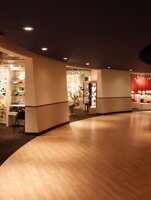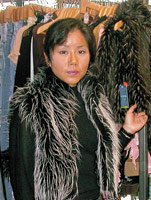Fashion District Heads Into a New Design Age
Los Angeles is hosting one of its largest fashion weeks ever, and the landscape of the city’s fashion core is taking a similarly promising turn.
Even though imports and slowness on some retail selling floors continue to hamper business, the Los Angeles Fashion District is reflecting a new level of growth in the look of its real estate portfolio. The manufacturing base continues to dwindle, but the creative element—along with the nuts and bolts of distribution and selling—is spurring demand for office and design space, and that’s creating opportunities for emerging centers such as the newly redesigned Gerry Building and others.
Along with the California Market Center (CMC), which has been transformed into a multiple-category merchandise center, the Gerry Building, Cooper Building, New Mart and other locations are helping to transform Los Angeles into a fashion capital worthy of hosting an internationally recognized fashion week, according to real estate executives.
“There’s a feeling that everyone in real estate and in the industry are working together more, because we want to make fashion week work,” said Larry Hudson, director of leasing for Gerry Building owner MJW Investments. “It used to be a little bit more contentious, with each building competing against the other, but that’s changed some.”
MJW recently celebrated the opening of its Gerry Building, a historic deco-moderne building that has been converted from old manufacturing lofts into apparel showrooms. MJW hopes to replicate what was done at the New Mart and have the Gerry become a key showplace for contemporary lines. So far, the building has lured a mix of young newcomers and veterans, among them designer Jeannie Lee of Jini & Co., who wanted a focused environment.
“I like the idea of this being more of a contemporary marketplace,” said Lee. “I like the building and all the glass doors. There’s focused fashion here.”
Other tenants include Jeff Murrell of Technics, which sells OK-47, ModRobes, Technics and MadSole, and Mark Encinias of Monta Mundo, which sells Nomad, Cannibal, Motor, Divinas Palabras and Pichiglas.
The nine-story building is a little more than 30 percent leased, and Hudson projects it to be 50 percent leased by the end of the year and fully leased by the end of 2003, which is on target with initial estimates.
Across the street from the Gerry, the Cooper Building has undergone a similar transformation from a primarily discount retail center to a wholesale center, attracting tenants including Bebe Stores Inc. over the past 18 months. Cooper Building executive Steve Hirsh has wrapped up the finishing touches on transforming the 11th floor of the building into trade show space. The project encompasses 22,500 square feet and is hosting an extension of Designers & Agents this market. The New York-based contemporary show, which has been housed in the New Mart since 1999, has expanded enough to require a second location.
Like Hudson, Hirsh is bullish about Fashion District real estate.
“There are some great opportunities out there in terms of building uses. The Los Angeles Fashion District has lots of creative resources, so we’re positive about the future,” he said.
With a waiting list of 150 tenants, the New Mart has a lot of reasons to feel positive, said general manager Ethan Eller. The Ninth Street building, also a former home to manufacturers, is fully occupied yet also has some changes in store. The building has leased 4,000 square feet of its second floor to the trade organization Fashion Business Inc., which will soon start construction on a new environmentally friendly training center aimed at helping new companies grow their businesses.
“This project, along with the prospects of a new fashion week, is fabulous for the area. Even with the new buildings coming, we welcome the competition and think it’s a great time for the Fashion District,” Eller said.
The California Market Center’s joint merchandising venture, combining apparel with the gift and home furnishings industries under one roof, should be put to the test in January when the center hosts apparel and gift markets at the same time. The CMC, which has been undergoing a floor-by-floor remodeling of its C building to accommodate the new gift and home tenants, will have two more floors, accounting for 40 showrooms opening in January. By then, the gift/home element will comprise seven floors and more than 80 permanent showrooms. By the end of 2003 the CMC will encompass 13 floors and a million square feet of gift space. Potentially, gift and home could represent 50 percent of the CMC.
In the meantime, apparel showrooms continue to maintain the majority of space. Eight new junior apparel showrooms opened this fall featuring lines including Sugar Kiss, Nikkies Threads, IT Jeans, Trust Me, Motion, Pop Connection, Power Trading and MDM Collection.
Several new contemporary showrooms are debuting this fashion week, including Lix Jeans, Billie Blues, Wildlife Works, Mavi Jeans, Votre Nom, Rebecca Bacon and Thomas Thomas. Two others are still in negotiations and four accessory showrooms are set to come online soon, according to CMC’s Sheri Mobley.
In addition, other tenants are undergoing expansion, among them Von Mozart, which is tripling its space. Retailer Charlotte Russe is boosting its corporate buying offices by 70 percent, and Ross Stores is adding 60 percent more space to accommodate more gift and home buyers.
Though the market centers are having no problems sustaining tenants, downtown Los Angeles real estate has been stabilizing lately, with vacancies climbing to about 18.7 percent for the third quarter compared to 15.8 percent last year, according to Cushman & Wakefield, which attributed the rise to weakness in the dot-com and telecommunications markets as well as general corporate downsizing. The Fashion District has seen some of that, but it’s holding its own.
“Because of the shrinking [apparel] space at the California Market Center, wholesale fashion space is at a premium,” noted Hudson. “But there’s a finite limit to what the market can bear.”
Steve Needleman, chief executive officer of Anjac Fashion Buildings, agrees. “There’s lots of showroom space out there, which is why I am doing residential projects,” he said. Needleman is converting space above his historic Orpheum Theatre into 37 live-work loft apartments that he hopes will become living spaces for fashion designers, architects and others. The project is set to open next summer.
MJW also sees opportunities with residential and other commercial real estate opportunities and is embarking on a 780,000-square-foot mixed-use project called Santee Court in the Fashion District, which recently won approvals.
























